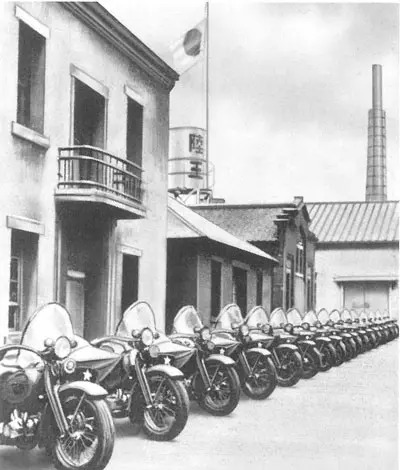Daiichi Sankyo Predecessor Company, Sankyo Co., Ltd. (Sankyo), walked a unique path in the early to mid-20th century by manufacturing and selling a Japanese version of Harley-Davidson’s iconic motorcycle.
Sankyo Shoten was founded in 1898 in Japan to sell “Taka-Diastase®,” a digestive enzyme agent based on the koji mold (Aspergillus oryzae) enzyme discovered by Dr. Jokichi Takamine. It later succeeded in the pharmaceutical business and made an organizational change in 1913 to become “Sankyo Co., Ltd. (Sankyo), a predecessor of a modern-day Daiichi Sankyo Co., Ltd.
Surprisingly, Sankyo Shoten was also engaged in importing and selling something completely different from pharmaceuticals—automobiles. This effort later led to Sankyo importing and selling Harley-Davidson motorcycles (also known as “Harleys” and manufactured by Harley-Davidson, Inc. in the United States) and even its own development and manufacturing of domestic motorcycles.
Decision to import automobiles in an era when cars were still rare
The story can be traced back to 1908, when there were only about 10 cars in Tokyo. Matasaku Shiobara, the founder of Sankyo Shoten, saw a Ford vehicle that Dr. Jokichi Takamine had brought back as a souvenir from the United States and decided to import automobiles, placing an order for several cars with Ford Motor Company, which was headquartered in Detroit.
With the support of Dr. Takamine, Sankyo Shoten became the exclusive distributor of Ford vehicles in Japan. The business, however, shortly came to a halt as the company failed to procure components or secure repair facilities. However, the move laid the groundwork for its motorcycle business during the Taisho (1912 to 1926) and Showa (1926 to 1989) Eras in Japan.
Commencing the import and sales of “Harleys”
In 1913, Sankyo Shoten became Sankyo Co., Ltd. (Sankyo), a business corporation engaged in the manufacture of pharmaceuticals, and in 1921, using its experience as a distributor of Ford vehicles, it participated in the establishment of a trading firm called “Koto Trading Company. Ltd.,” which was founded to deal with automobile-related parts and machines.
Two years later in 1923, Koto Trade began importing and selling Harley-Davidson motorcycles. That same year, the eastern Japanese region of Kanto was hit by a powerful earthquake—the Great Kanto Earthquake—which caused catastrophic damage to railroads and, consequently, boosted demand for motorcycles as another means of transportation.
In 1931, Koto Trade established “Harley-Davidson Motorcycle Sales,”where it transferred its motorcycle business.
Launching the Japanese version of the Harley-Davidson motorcycle

Brand new Japan domestic Harleys in 1935
The domestic production plan of Harley-Davidson-type motorcycles started at the end of 1931 under various economic conditions, including sharp rises in the price of imported vehicles due to the Japanese government’s reimposition of an embargo on the export of gold.
Having obtained a manufacturing license from Harley-Davidson Motor Company in 1932, Harley-Davidson Motorcycle Sales started development at the Shinagawa Daiichi plant, which it took over from Sankyo. Three years later in April 1935, what became known as the Japanese version of the Harley-Davidson motorcycle was finally completed. In line with the completion, the company changed its name to ‘Harley-Davidson Motorcycle’ and started sales.
Demand was high, particularly among customers interested in Harleys. “Sankyo Nainenki” was established to specialize in manufacturing and to deal with the rising demand. The company was eventually dissolved due in part to Japan’s defeat in the war, although it came back in 1950 under a new name outside of the Sankyo group of companies.
Aware of the automobile industry’s success in Japan, Mr. Shiobara was later quoted as saying, “If we stayed on as a distributor of Ford vehicles, I might have been able to capitalize on the momentum and enjoy some success in the industry.”
Nevertheless, Shiobara’s inquisitive and enthusiastic spirit has been passed down to modern-day Daiichi Sankyo and has served as a driving force for discovering innovative pharmaceuticals and protecting people’s lives.